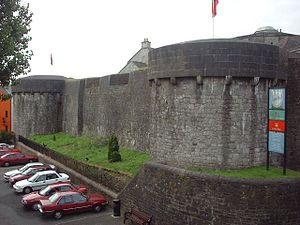Athlone Castle
| Athlone Castle | ||
|---|---|---|
|
Athlone Castle |
||
| Alternative name (s): | Caisleán Bhaile Átha Luain | |
| Creation time : | 1210 | |
| Castle type : | Niederungsburg | |
| Conservation status: | rebuilt and restored | |
| Standing position : | English royal family | |
| Construction: | Quarry stone | |
| Place: | Athlone | |
| Geographical location | 53 ° 25 '23.4 " N , 7 ° 56' 33.9" W | |
| Height: | 43 m ASLTemplate: height / unknown reference | |
|
|
||
Athlone Castle ( Irish Caisleán Bhaile Átha Luain ) is a low castle in Athlone in the Irish county of Westmeath . The restored 12th century complex is a popular tourist attraction.
history
The oldest documented castle of Athlone was a wooden structure that King Tairrdelbach Ua Conchobair von Connacht had built in 1129, presumably on the site of today's castle. The stone castle, which has been preserved to this day, dates back to 1210 and was commissioned for King John Ohneland by his Irish legal advisor , Bishop John de Gray from Norwich . It was built to defend the river crossing at Athlone and to create a bridgehead for the Anglo-Norman conquest of Connacht.
The castle from 1210 was a freestanding, polygonal tower on an artificial hill or mound built for this purpose or an already existing one . This tower can still be seen today as the central keep of the castle , although it has been heavily modified . At the time Athlone Castle was built, the Shannon flowing through Athlone was very different from what it is today. In its early days the castle was probably protected by a moat .
At the end of the 13th century (around 1276), the castle was further fortified, so the original " motte " was surrounded by a curtain wall with three-quarter towers at every corner. These facilities, which have also undergone major changes, can still be seen today. Sir William Brabazon , Justiciar of Ireland , had the castle rebuilt in 1547. The outer walls and towers were subjected to violent fire during the sieges of Athlone 1690-1691 and were later completely destroyed when lightning struck the castle in 1697. The castle as seen today shows traces of extensive renovations during Napoleon's time when it was modernized and adapted for the installation of artillery . Today the low round towers are somehow reminiscent of Martello towers (also from the time of Napoleon), as you can find them on the Irish east coast near Cork and, to a lesser extent, on the west coast of Ireland.
The large-format Ordnance Survey map from 1874 names some details that existed at the castle at that time. This includes officers and crew quarters, quarters for the chief gunners, a guard house, washrooms, a cooking house, a kitchen and a drawbridge . The officers and crew quarters were housed in a two-story barracks with five bays above the main street. This Georgian building dates from around 1810.
A close examination of the castle reveals many interesting details, including the shape of a “Sally Gate” in the castle wall above the Shannon, an arrow loop for archers in the wall towards Castle Street and loopholes for pistols and rifles in the walls at the entrance ramp . An important detail that disappeared in the 20th century was the drawbridge, which only survived until the 1940s.
The keep of Athlone Castle is a National Monument . Part of Athlone's defenses for 750 years, the castle became a museum operated by the Old Athlone Society in 1966 and also received a modern visitor center from the city council in 1991. Athlone Castle is the linchpin for understanding the evolution of Athlone and connects modern Athlone with its Norman founders.
restoration
Athlone Castle reopened in 2012 after a multi-million euro renovation. She transformed the castle into a modern, multimedia tourist attraction. It has eight newly designed exhibition spaces that are both a chronological and thematic show a sequence including 3D maps, audiovisual installations and illustrations of the famous illustrator Victor Ambrus (known from the TV program Time Team of Channel 4 ).
Individual evidence
- ^ TW Moody: A New History of Ireland . Chapter 8 (1547): A Chronology of Irish History . Oxford University Press, Oxford 1989. ISBN 978-0-19-821744-2 .
- ^ Athlone Castle . In: Athlone Heritage . Archived from the original on September 14, 2011. Retrieved on May 22, 2019.
- ^ Athlone Castle Now Open . Athlone Art and Heritage Ltd .. Archived from the original on January 14, 2013. Retrieved on May 22, 2019.


